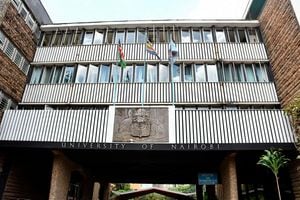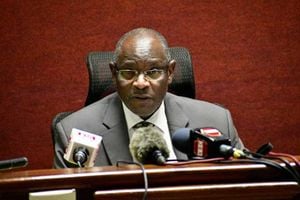
University of Nairobi students hold protests in Nairobi’s central business district on September 2,2024 against the university funding model.
Kenyans have a chance to redefine the best model for funding universities and tertiary education following the High Court’s nullification of the variable scholarship and loan system introduced two years ago by the Kenya Kwanza administration.
Right from its inception, the model fronted by President William Ruto’s administration as the panacea to the country's higher education funding was tragically flawed. It was conceptually defective and practically unrealistic.
Not surprisingly, High Court Judge Chacha Mwita described it as arbitrary, obscure, expensive, undefined illegality, and an affront to the right to education.
The problem with higher education is the lack of coherent policy and sustainable funding models. The policies, funding and governance systems are predicated on the politics of the day.
Whimsical directives are the order of the day while university managers have been pulped to kowtow to external power brokers.
Given the circumstances, the High Court ruling provides a chance for critical re-examination of university funding to establish viable models.
The core issues to look at are: number of students seeking university admission, state of university infrastructure, number and quality of university degree programmes, actual cost for each degree module, government’s capability to provide funding and the alternative sources of funds.
Related to this are applicable policies and legislation, which include admission, governance and employment.
University funding has consumed the minds of the various governments since independence. Until independence in 1963 and up to 1974, the government fully funded university education and the objective was to create high calibre human resources to drive the economy of a nascent democracy.
However, the system was revised with introduction of a loan scheme, where the government funded universities and all students given loans to be repaid upon graduation.
This worked for a while especially in the 1970s and largely because there was only one university – Nairobi and its constituent college – Kenyatta – which was later upgraded and charted as a fully-fledged university in 1985.
A major policy and funding shift came in the early 1990s with introduction of cost-sharing as a consequence of the structural adjustment programmes (SAPs) fostered by the World Bank and the International Monetary Fund (IMF).
A major plank of the reforms was the creation of the Higher Education Loans Board (Helb) in 1995, which was charged with disbursement of loans and scholarships and recovery.
Helb made a difference for a while as it was able to give targeted loans and scholarships to all deserving students and enforced recovery that enabled it to create a revolving fund.
Later on, in 2016, the government introduced a new policy, differentiated unit cost, whose objective was to give funding based on the actual cost of mounting a degree programme.
This did not fly ostensibly because of insufficient budgetary allocation. It was replaced by the variable scholarship and loan model in 2022, but this has now sunk with the court’s nullification.
Against this backdrop, the question is, what should we do to create a sustainable funding mechanism for higher education?
For starters, demand for higher education is increasing every year which necessitates expansion of learning opportunities.
Inevitably, funding requirements are bound to rise, which requires proper projections and planning. From a budgetary perspective, the country has to ask itself, what is the realistic figure for running universities and other tertiary institutions every year and work out block projections – three to five years – and also identify funding sources.
Secondly, the country has to confront the question: do we need all the universities we have to date? Can we have a moratorium on creation of new universities and instead, collapse and merge unviable ones as has happened in countries such as South Africa and Rwanda?
Records by the Commission for University Education (CUE) show that the country has 79 universities and constituent colleges.
These comprise 35 public universities, three specialised universities and five constituent colleges. In addition, there are 28 chartered private universities, two constituent colleges and six operating with letters of interim authority.
The challenge with the enormous expansion of the universities it that it is not driven by demand but by extraneous considerations, mainly political expediency. Most universities duplicate courses and programmes, meaning there is no value addition. And they operate huge administrative costs, including payroll, leaving minimal resources for academic work and research.
South Africa, a bigger economy compared to Kenya, has 26 public universities with an enrollment of more than one million students. Kenya’s 79 universities have a combined enrollment of about 600,000 students, indicating underutilised capacity and the reason for dissolution and mergers.
Third, universities’ governance structures are bloated and burdensome. The universities are top-heavy with the appointments skewed in favour of political wheeler dealers, creating entities that are badly managed and poorly supervised. Corruption, nepotism and greed thrive as best demonstrated by Moi University which has been tottering on the brink of collapse.
Many others are in a similar situation. Last month, the Ethics and Anti-Corruption Commission (EACC) announced that it was investigating some 18 public universities over cases of fraud, misuse of public resources and unethical conduct. But this was just the tip of the iceberg.
Fourth, the higher education sector has unnecessarily many regulatory and supervisory entities that duplicate roles and cause confusion and disorganisation.
These are the Commission for University Education (CUE), Kenya Universities and Colleges Central Placement Services (KUCCPS), the Universities Fund (UF) and the Kenya National Qualification Authority (KNQA). The functions scattered across these agencies should be collapsed and put under one entity and the universities left to operate as autonomous institutions, among others managing admissions, placement and financing.
Indeed, the High Court was emphatic that there was confusion in the sector occasioned, among others, by the delays in the selection and placement of students to colleges due to a lack of clear instructions from KUCCPS.
In a way, the court intimated that there were multiple agencies in higher education performing little bits of tasks that were unnecessary but whose aggregate result was to derail processes and programmes.
Moving forward, President Ruto should let the universities and experts formulate plans and policies for sustainable higher education. The focus should be on proper costing, identifying viable funding sources, effective systems for resource management and innovative leadership to guarantee quality higher education.
David Aduda is a Consulting Editor and Education Specialist.













